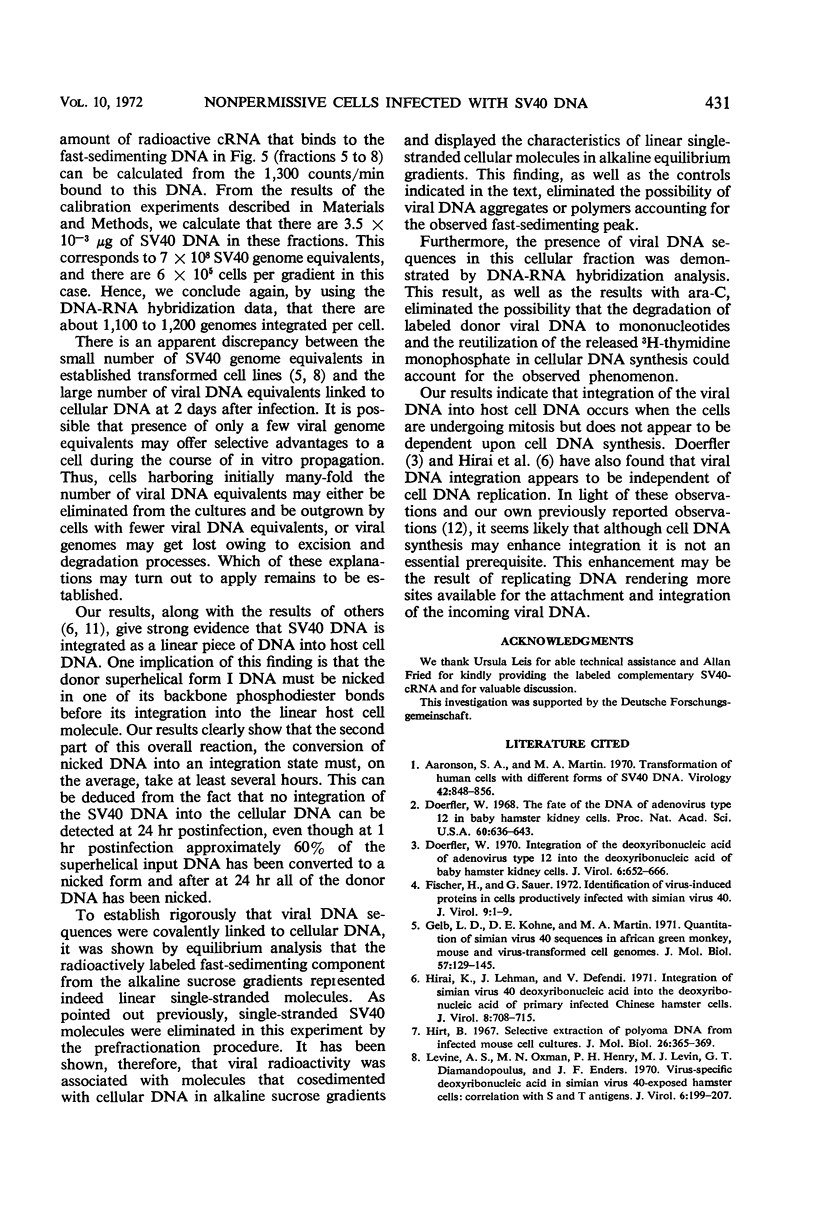Abstract
Nonpermissive 3T3 cells were infected with purified superhelical simian virus 40 (SV40) deoxyribonucleic acid I (DNA I). One hour after infection, approximately 60% of the intracellular SV40 DNA was converted to relaxed forms. One day after infection, all intracellular SV40 DNA was present as slow-sedimenting material, and no SV40 DNA I was detectable. At 2 days after infection there appeared viral DNA sequences cosedimenting with cellular DNA during alkaline velocity centrifugation. Furthermore, by both alkaline equilibrium gradient centrifugation and by DNA-ribonucleic acid hybridization analysis, covalent linkage of viral DNA sequences to cellular DNA was demonstrated. Integration of SV40 DNA into cellular DNA did not appear to require DNA synthesis, although DNA synthesis followed by mitotic division of the cells enhanced the amount of viral DNA integrated. Based on data obtained by two different methods, it was calculated that 1,100 to 1,200 SV40 DNA equivalents must be integrated per cell by 48 hr after infection.
Full text
PDF







Selected References
These references are in PubMed. This may not be the complete list of references from this article.
- Aaronson S. A., Martin M. A. Transformation of human cells with different forms of SV40 DNA. Virology. 1970 Dec;42(4):848–856. doi: 10.1016/0042-6822(70)90334-x. [DOI] [PubMed] [Google Scholar]
- Doerfler W. Integration of the deoxyribonucleic acid of adenovirus type 12 into the deoxyribonucleic acid of baby hamster kidney cells. J Virol. 1970 Nov;6(5):652–666. doi: 10.1128/jvi.6.5.652-666.1970. [DOI] [PMC free article] [PubMed] [Google Scholar]
- Doerfler W. The fate of the DNA of adenovirus type 12 in baby hamster kidney cells. Proc Natl Acad Sci U S A. 1968 Jun;60(2):636–643. doi: 10.1073/pnas.60.2.636. [DOI] [PMC free article] [PubMed] [Google Scholar]
- Fischer H., Sauer G. Identification of virus-induced proteins in cells productively infected with simian virus 40. J Virol. 1972 Jan;9(1):1–9. doi: 10.1128/jvi.9.1.1-9.1972. [DOI] [PMC free article] [PubMed] [Google Scholar]
- Gelb L. D., Kohne D. E., Martin M. A. Quantitation of Simian virus 40 sequences in African green monkey, mouse and virus-transformed cell genomes. J Mol Biol. 1971 Apr 14;57(1):129–145. doi: 10.1016/0022-2836(71)90123-9. [DOI] [PubMed] [Google Scholar]
- Hirai K., Lehman J., Defendi V. Integration of simian virus 40 deoxyribonucleic acid into the deoxyribonucleic acid of primary infected Chinese hamster cells. J Virol. 1971 Nov;8(5):708–715. doi: 10.1128/jvi.8.5.708-715.1971. [DOI] [PMC free article] [PubMed] [Google Scholar]
- Hirt B. Selective extraction of polyoma DNA from infected mouse cell cultures. J Mol Biol. 1967 Jun 14;26(2):365–369. doi: 10.1016/0022-2836(67)90307-5. [DOI] [PubMed] [Google Scholar]
- Levine A. J., Teresky A. K. Deoxyribonucleic acid replication in simian virus 40-infected cells. II. Detection and characterization of simian virus 40 pseudovirions. J Virol. 1970 Apr;5(4):451–457. doi: 10.1128/jvi.5.4.451-457.1970. [DOI] [PMC free article] [PubMed] [Google Scholar]
- Levine A. S., Oxman M. N., Henry P. H., Levin M. J., Diamandopoulos G. T., Enders J. F. Virus-specific deoxyribonucleic acid in simian virus 40-exposed hamster cells: correlation with S and T antigens. J Virol. 1970 Aug;6(2):199–207. doi: 10.1128/jvi.6.2.199-207.1970. [DOI] [PMC free article] [PubMed] [Google Scholar]
- SABIN A. B., KOCH M. A. SOURCE OF GENETIC INFORMATION FOR SPECIFIC COMPLEMENT-FIXING ANTIGENS IN SV40 VIRUS-INDUCED TUMORS. Proc Natl Acad Sci U S A. 1964 Nov;52:1131–1138. doi: 10.1073/pnas.52.5.1131. [DOI] [PMC free article] [PubMed] [Google Scholar]
- Sambrook J., Westphal H., Srinivasan P. R., Dulbecco R. The integrated state of viral DNA in SV40-transformed cells. Proc Natl Acad Sci U S A. 1968 Aug;60(4):1288–1295. doi: 10.1073/pnas.60.4.1288. [DOI] [PMC free article] [PubMed] [Google Scholar]
- Sauer G., Hahn E. C. The interaction of SV40 with SV40-transformed and non-transformed monkey kidey cells. Z Krebsforsch. 1970;74(1):40–47. doi: 10.1007/BF00524678. [DOI] [PubMed] [Google Scholar]
- Sauer G., Kidwai J. R. The transcription of the SV40 genome in productively infected and transformed cells. Proc Natl Acad Sci U S A. 1968 Dec;61(4):1256–1263. doi: 10.1073/pnas.61.4.1256. [DOI] [PMC free article] [PubMed] [Google Scholar]
- Todaro G. J., Green H. Cell growth and the initiation of transformation by SV40. Proc Natl Acad Sci U S A. 1966 Feb;55(2):302–308. doi: 10.1073/pnas.55.2.302. [DOI] [PMC free article] [PubMed] [Google Scholar]
- Trilling D. M., Axelrod D. Encapsidation of free host DNA by simian virus 40: a simian virus 40 pseudovirus. Science. 1970 Apr 10;168(3928):268–271. doi: 10.1126/science.168.3928.268. [DOI] [PubMed] [Google Scholar]
- Trkula D., Kit S., Kurimura T., Nakajima K. Infectivity of molecular forms of simian virus 40 DNA. J Gen Virol. 1971 Mar;10(3):221–229. doi: 10.1099/0022-1317-10-3-221. [DOI] [PubMed] [Google Scholar]
- Westphal H., Dulbecco R. Viral DNA in polyoma- and SV40-transformed cell lines. Proc Natl Acad Sci U S A. 1968 Apr;59(4):1158–1165. doi: 10.1073/pnas.59.4.1158. [DOI] [PMC free article] [PubMed] [Google Scholar]
- Williams A. E., Vinograd J. The buoyant behavior of RNA and DNA in cesium sulfate solutions containing dimethylsulfoxide. Biochim Biophys Acta. 1971 Jan 28;228(2):423–439. doi: 10.1016/0005-2787(71)90048-7. [DOI] [PubMed] [Google Scholar]
- Winocour E. The investigation of oncogeic viral genomes in transformed cells by nucleic acid hybridization. Adv Cancer Res. 1971;14:37–70. doi: 10.1016/s0065-230x(08)60518-7. [DOI] [PubMed] [Google Scholar]


